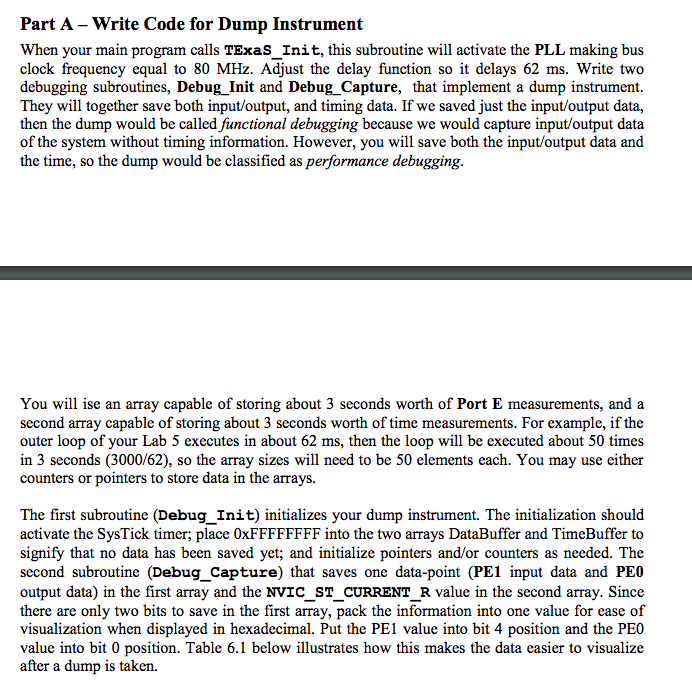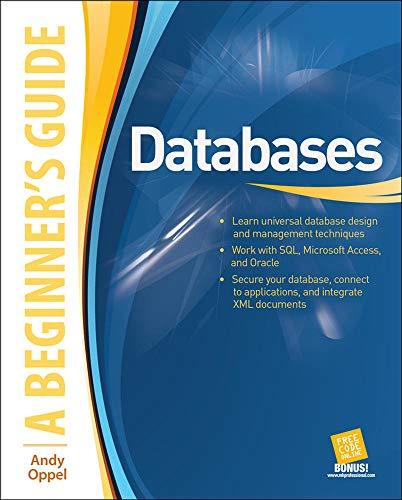Answered step by step
Verified Expert Solution
Question
1 Approved Answer
Please the code should be in ASM language Part A- Write Code for Dump Instrument When your main program calls TExas Init, this subroutine will


Please the code should be in ASM language
Part A- Write Code for Dump Instrument When your main program calls TExas Init, this subroutine will activate the PLL making bus clock frequency equal to 80 MHz. Adjust the delay function so it delays 62 ms. Write two debugging subroutines, Debug Init and Debug Capture, that implement a dump instrument. They will together save both input/output, and timing data. If we saved just the input/output data, then the dump would be called functional debugging because we would capture input/output data of the system without timing information. However, you will save both the input/output data and the time, so the dump would be classified as performance debugging You will ise an array capable of storing about 3 seconds worth of Port E measurements, and a second array capable of storing about 3 seconds worth of time measurements. For example, if the outer loop of your Lab 5 executes in about 62 ms, then the loop will be executed about 50 times in 3 seconds (3000/62), so the array sizes will need to be 50 elements each. You may use either counters or pointers to store data in the arrays. The first subroutine (Debug Init) initializes your dump instrument. The initialization should activate the SysTick timer; place 0xFFFFFFFF into the two arrays DataBuffer and TimeBuffer to signify that no data has been saved yet; and initialize pointers and/or counters as needed. The second subroutine (Debug_ Capture) that saves one data-point (PE1 input data and PEO output data) in the first array and the NVIC ST CURRENT R value in the second array. Since there are only two bits to save in the first array, pack the information into one value for ease of visualization when displayed in hexadecimal. Put the PE1 value into bit 4 position and the PE0 value into bit 0 position. Table 6.1 below illustrates how this makes the data easier to visualize after a dump is taken. Part A- Write Code for Dump Instrument When your main program calls TExas Init, this subroutine will activate the PLL making bus clock frequency equal to 80 MHz. Adjust the delay function so it delays 62 ms. Write two debugging subroutines, Debug Init and Debug Capture, that implement a dump instrument. They will together save both input/output, and timing data. If we saved just the input/output data, then the dump would be called functional debugging because we would capture input/output data of the system without timing information. However, you will save both the input/output data and the time, so the dump would be classified as performance debugging You will ise an array capable of storing about 3 seconds worth of Port E measurements, and a second array capable of storing about 3 seconds worth of time measurements. For example, if the outer loop of your Lab 5 executes in about 62 ms, then the loop will be executed about 50 times in 3 seconds (3000/62), so the array sizes will need to be 50 elements each. You may use either counters or pointers to store data in the arrays. The first subroutine (Debug Init) initializes your dump instrument. The initialization should activate the SysTick timer; place 0xFFFFFFFF into the two arrays DataBuffer and TimeBuffer to signify that no data has been saved yet; and initialize pointers and/or counters as needed. The second subroutine (Debug_ Capture) that saves one data-point (PE1 input data and PEO output data) in the first array and the NVIC ST CURRENT R value in the second array. Since there are only two bits to save in the first array, pack the information into one value for ease of visualization when displayed in hexadecimal. Put the PE1 value into bit 4 position and the PE0 value into bit 0 position. Table 6.1 below illustrates how this makes the data easier to visualize after a dump is takenStep by Step Solution
There are 3 Steps involved in it
Step: 1

Get Instant Access to Expert-Tailored Solutions
See step-by-step solutions with expert insights and AI powered tools for academic success
Step: 2

Step: 3

Ace Your Homework with AI
Get the answers you need in no time with our AI-driven, step-by-step assistance
Get Started


